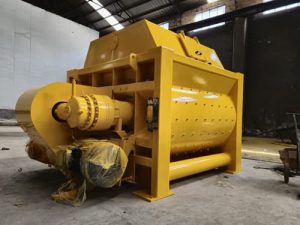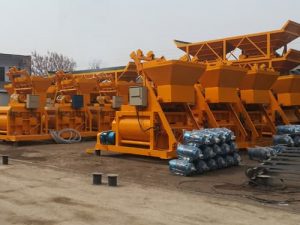Relative News
Products
Concrete batching plant are professional equipment used to produce concrete. They are widely used in construction, roads, bridges and other projects, and play a key role in project quality and construction efficiency.The following is an introduction from the basic concepts, main types, production processes, management points and other aspects.
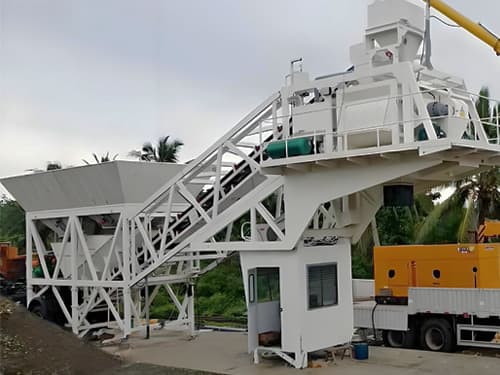
Mobile | Stationary Concrete Plant
1. Basic Concepts
Concrete batching plant is a combined device that mixes cement, aggregates (sand, stone), water and admixtures in a certain proportion and stirs them into uniform concrete. It is also called a concrete prefabrication site. It has the advantages of high mechanization and automation, high production efficiency, ability to ensure concrete quality and save cement. It is often used in large and medium-sized water conservancy, power, bridge and other projects with large concrete engineering volume, long construction period and concentrated construction sites.
2. Main Types
2.1. Division by structure:
Fixed concrete batching plant: It is a permanent facility, usually used in large-scale construction projects, with high production capacity and operation efficiency of automatic control system, suitable for special projects such as high-rise buildings or large bridges. It includes basic components such as concrete mixing device, aggregate feeding system, cement silo, water supply system and control system.It is fixed in position and inconvenient to transport to the construction site.
Mobile concrete batching plant: It is ideal for short-term construction projects. It has a smaller capacity than a fixed mixing plant, is mobile and easy to use on construction sites where concrete is needed. Its investment and operating costs are higher than those of a fixed mixing plant since the mobile chassis. It is suitable for small enterprises and special projects. The quality of the concrete produced is reliable.
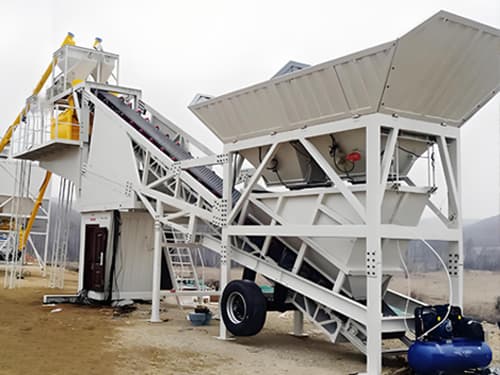
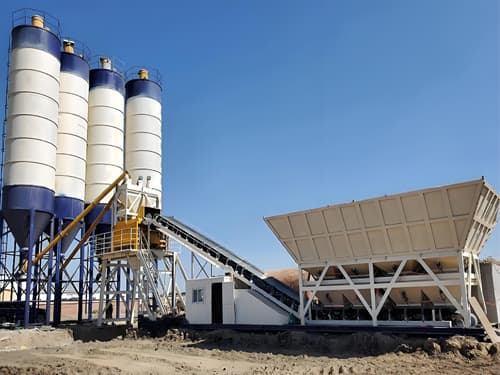
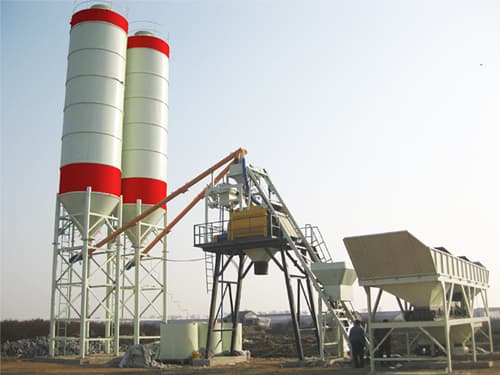
Foundation free concrete batching plant: It is considered to be a concrete production facility between mobile and fixed concrete mixing plants. It adopts a modular design, is easy to transport and install, and is suitable for rapid production of concrete on construction sites. It is also suitable for small projects, temporary construction sites and narrow work areas. Compared with fixed mixing plants, it’s cost not much higher, just add one H steel type chassis, customer can save the installation cost.
2.2. Classification by use
Commodity concrete batching plant: It is mainly used for commercial purposes and needs to be efficient, economical, and meet environmental protection requirements.
Engineering concrete batching plant: For self-use, it is necessary to consider whether it is consistent with its own project.
2.3. Division by layout process
One-stage: Lift sand and gravel aggregates, cement, etc. to the top silo of the batching plant at one time. Various materials are carried out from top to bottom according to the production process, and finally discharged from the bottom. It is often seen in mixing buildings. Its mixing efficiency is high, but the construction is difficult, the demolition is inconvenient, and the investment cost is high.
Two-stage: After weighing the aggregate, the mixer hopper is lifted again to mixer body. Although it occupies a large area and the mixing efficiency is slightly lower than the first-stage type, it is easy to disassemble and assemble, has low manufacturing cost, and is easy to install. It is widely used, and the production capacity of the improved two-stage batching plant can be comparable to that of the first-stage type.
2.4. Division by the number of mixers
Single mixer batching plant: Suitable for general production needs.
Double mixer batching plant: The model name is 2HZS series concrete batching plant, such as 2HZS25 concrete batching plant with 2 JS500 mixer, with a theoretical productivity of 2x25m³/h, which is a supplement to the same model batching plant.
2.5. Classification by weighing method:
Independent weighing: Each material is equipped with a separate weighing unit, and each material is weighed before being added to the mixer for mixing. The weighing accuracy is high, but the design is complex.
Cumulative weighing: All aggregates are added to the same hopper, which is more likely to cause accumulation of errors, which is not conducive to the final production. The more batching bins there are, the more likely there will be deviations, which is not suitable for large-scale projects.
3. Production Process
3.1. Aggregate weighing:
The required aggregates (including sand and gravel) are transported to the factory by car, which are required to meet the use standards or be washed by a stone washer, and then loaded into the closed aggregate bin by a loader.
A weighing scale is connected under the aggregate bin to weigh various aggregates according to the mass ratio. The weighed aggregates are transported to the aggregate transition bin by a belt conveyor (semi-enclosed), and then fall into the concrete mixer for mixing by opening the door of the transition bin.
Powder weighing (cement, fly ash, etc.): The required powder is transported to the factory by a sealed tank truck, and then pumped into the cement silo by a tank truck or other conveying device through a compressed air pump. The butterfly valve is opened, and the powder falls into the screw conveyor, and then the screw conveyor is transported to the weighing bucket for weighing. The weighing is deducted according to the aggregate ratio error. The weighed cement opens the butterfly valve by the cylinder under the cement weighing bucket and slides into the concrete mixer for mixing.
3.2. Water weighing:
The required water is pumped into the weighing box by the water pump, and the weighed water is pumped out by the booster pump and sprayed into the mixer through the water sprayer.
3.3. Admixture weighing:
The required additives are pumped from the additive box to the weighing box by the self-priming pump, and the weighed additives are put into the water tank and sprayed into the concrete mixer through the water sprayer.
3.4. Mixing:
Aggregates, powders, water and admixtures are put into the concrete mixer according to the set time. Under the stirring of the double-channel mixing blades on the two reverse stirring shafts, the materials are squeezed, rubbed, sheared and convected, thereby violently forcing the mixing.
When the mixing time is up, the cylinder of the mixer door opening device opens the door, and the mixer blades push the mixed concrete to the transport truck waiting under the concrete mixer (before entering the transport truck, take a part of the mixed concrete for sampling and testing to check whether it meets the requirements).
After all qualified, they exit and close the door to enter the next mixing cycle, and the finished material is transported to the construction site by the concrete tank truck.
4. Key points of management
4.1. Equipment management
The person in charge of electromechanical equipment should guide, inspect and supervise the driver to perform “cross operation” on the equipment before the opening of the market every day.
When pouring large-volume concrete components with continuous pouring requirements, special process control should be carried out on the equipment, and appropriate equipment emergency measures should be formulated, such as focusing on the maintenance of parts prone to failure and ensuring appropriate spare parts reserves; contacting the power supply department and requiring it to provide reliable power guarantee; keeping the standby generator in good technical condition; maintaining and preparing enough concrete transport vehicles (to be slightly surplus).
The concrete batching plant should be equipped with two hydraulic pipes so that when the concrete transport vehicle fails, other power can be used to unload the concrete in the tank; appropriately spare pneumatic picks should be prepared to promptly remove the solidified concrete in the tank of the concrete mixing transport vehicle. When the equipment is overhauled, adjusted, maintained and cleaned, the main power switch must be turned off and a warning sign of “under maintenance, no closing” should be hung.
The concrete batching plant has many electronic control equipment and high technical content, and should be equipped with experienced electricians to be responsible for the daily maintenance of electrical equipment.
4.2. Environmental improvement measures
Dust reduction treatment: Material yard, aggregate transportation and backstage material yard packaging; dust collectors are installed at dust-prone points in the station; the backstage material yard is semi-enclosed, so when installing dust collectors, spray equipment can be installed at the material yard entrance and the upper part of the material yard to create a water curtain for dust reduction; high-pressure spray devices can be installed in the station to regularly clean up dust in the station, and can also serve the purpose of watering green vegetation.
Sewage treatment: Sewage is mainly divided into wastewater from mixer trucks and mixer washing and natural rainwater, which can be collected and classified, and directly supplied to production and vehicle and main station washing through reasonable sewage treatment.
Waste treatment: Waste is mainly divided into residual waste in mixing tank trucks and wastewater precipitation from sewage treatment, which can be reasonably equipped as additives in concrete production of different specifications and grades after filtration and classification.
Noise control: To address production noise, a concrete enclosed structure can be used in the design of the entire station to control the noise within the closed production workshop. For example, a closed air compressor room can be built specifically for the air compressor, and shock-absorbing pads can be added to the vibrating parts to reduce the generation of noise sources. To address vehicle noise, natural gas vehicles can be used and additional walls can be added within the station to reduce vehicle noise output.
Minrui Video: https://www.youtube.com/@minruigroup
